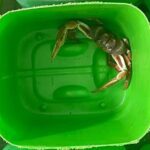Home sweet home, except for bats in North America whose homes are harbouring a deadly fungus. In a little over a decade, millions of bats have died because of white-nose syndrome. With no cure available, the disease continues to spread across the continent.
The white-nose syndrome fungus, Pseudogymnoascus destructans, colonizes the skin of hibernating bats, leading to dehydration, electrolyte loss, and eventually starvation. The disease is named for the distinctive whitish growth that appears on the muzzle and wings of its victims.
One reason why P. destructans is so dangerous is that it can survive without a host in the sediment on the cave floor, meaning that even colonies without infected bats could still be at risk for the disease.
But knowing the fungus is there and getting rid of it are two very different things. Large bat caverns have millions of unreachable cracks and crevices where the fungus could hide out from even the most fastidious cleaning.
New research published in the Canadian Journal of Microbiology investigates volatile organic compounds (VOCs) as a potential solution. As gases, VOCs can slip into the narrowest nooks and crannies, and VOCs even limit P. destructans growth.
The authors compared the antifungal activity of four VOCs—methyl-1-butanol, propionic acid, 2-methyl-1-propanol, and 1-pentanol—in laboratory conditions and in sediment collected from a bat colony.
As expected, in Petri dish assays, all four compounds stopped fungus growth within a few hours of treatment, with 2-methyl-1-butanol and 2-methyl-1-propanol showing effects in as little as 30 minutes.
Next, the authors checked whether the antifungal activity of the VOCs was limited to P. destructans alone or if it was a broad-spectrum anti-fungicide by repeating the experiment with P. pannorum and P. roseus, two related fungus species that do not cause white-nose syndrome.
All four VOCs were specific to P. destructans; growth of the fungus tanked by over 85% during treatment, whereas P. pannorum and P. roseus only saw modest 30% decreases in growth. These data suggest that a potential VOC treatment of an infected colony would have little effect on the other microbes in the ecosystem.
Buoyed by these results, it was time for the researchers to try VOCs in the real world. They collected sediment from a wild bat colony, spiked it with P. destructans, and then treated it with the VOCs.
Despite encouraging results in the petri dish, propionic acid was entirely ineffective at controlling P. destructans, even after seven days of treatment at five-times the concentration that eradicated P. destructans in laboratory conditions.
The other VOCs also required high doses to be effective in sediment but were able to wipe out all P. destructans colonies within three days. The antifungal effects of 2-methyl-1-propanol were especially effective; they became apparent within the first day of treatment.
What happened? The authors mused that the unique physical quirks of some VOCs, such as their vapor pressure, may have resulted in their uneven distribution in the sediment. Alternatively, the sediment could contain some chemical or other agent that protected the fungus from the effects of some VOCs, but not others; an effect observed in cell culture studies.
Regardless of the cause, the difference between the petri dish and sediment tests highlights the difficulty in translating basic scientific discoveries into field applications.
The promising data from sediment VOC treatments that did work suggests that an effective and specific way to kill P. destructans within bat colonies may soon be within reach.
Read the paper: Volatile organic compounds kill the white-nose syndrome fungus, Pseudogymnoascus destructans, in hibernaculum sediment in the Canadian Journal of Microbiology.
Banner image: Little brown bat, Myotis lucifugus | Sherri and Brock Fenton
Updated August 18, 2020.




